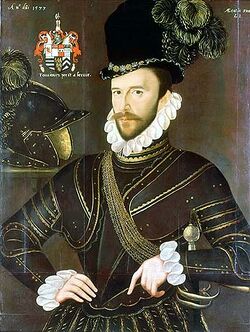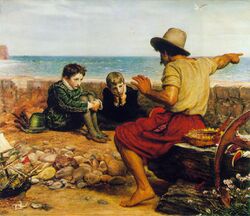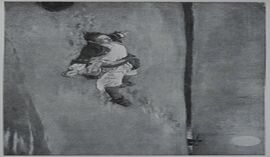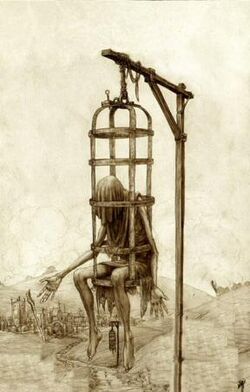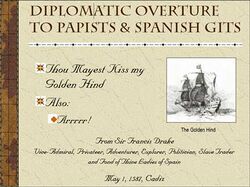Sir Francis Drake
Sir Francis Drake was born in Tavistock, Devon, in February 1540. He was the eldest of the twelve sons of Charlie Drake, a Protestant farmer, preacher, and comedian known for his ferocious hatred of Catholics and cheerful catchphrase "Can I burn you now, Paddy?" Unlike other famous British explorers, Drake's family were not wealthy but astute self-promotion and an unparalleled ability to kill Spaniards endeared him to the Queen and common people alike.
But it could have all ended much differently, and Drake was in many ways lucky to survive childhood. He was nine when the Prayer Book Rebellion swept seemingly unstoppably across England’s South West. Tavistock was soon threatened by an army of pro-Catholic protestors bent on destruction. These men, mostly landless Cornish peasants, had turned their pitch-forks against their overlords to seek the restoration of the true church, the abolition of the Book of Common Prayer and greater access to pasty-grazing land.
The rebellion tapped into resentment over the enclosure of common land, becoming especially popular upon the adoption of a revised slogan - “Kill all gentlemen”, "Kill all Humans" having failed to gain the expected support. Drake’s family - with its ties to the local peerage – fled to Kent where support for Protestantism was firmer and there were opportunities for hop-picking holidays.
It is said that this early brush with danger affected Drake deeply, sparking a life-long aversion to Catholicism and familiarising the young boy with life beyond the narrow confines of rural Devonshire. Drake himself never spoke of the time, stating only “Papish incense doth trouble my nose and I have no fondness for ostentatious prayer – not with my knees.”
Francis the Seafarer
How the son of a tenant farmer came to be a sailor is unclear. What is certain is that by the age of twelve the young Francis was already an apprentice seaman on the cross channel route. Here he amassed a fortune avoiding excise duty on imported continental brandy. He also made his first impact on British culture by introducing the country to tobacco in the form of cheap cigarettes smuggled from Calais hypermarches. At twenty three he became owner-master of a trading-barque when its previous owner, John FitzHugh, died unexpectedly from blood-poisoning. The finest physicians the Elizabethan age could muster examined the corpse and declared that the fatal septacaemia had been brought on by the dagger FitzHugh had inexplicably thrust between his own shoulder blades. Drake was the first to find the body of his beloved master and thus the first to hear news of his bequest, which was written across the walls of the master’s cabin in his own blood. For the rest of his life Sir Francis kept the dagger (fortuitously already inscribed with his own name) as a remembrance of his generous benefactor.
From that moment onwards Drake used his wealth and connections to indulge his twin passions:
“Ye pursuit of greater fortune yet and ridding [ye] worlde of Dagoes”.
In 1568, Sir John Hawkins ignored accusations of nepotism to appoint Drake lead navigator to his West Indies expedition. Despite never having never sailed further than Dieppe, Drake successfully took the fleet to the port of San Juan de Ulua, Mexico. Here they became trapped in harbour by a superior Spanish fleet and an inability to sail through the island to escape. Drake's reputation was made when he was one of only two captains to fight his way free, losing two thirds of his crew in the process but retaining the plunder from the Spanish city. His taste for adventure had begun, as had his appetite for the spoils of war.
The Birth of a Legend
In 1572 Drake captured the town of Nombre de Dios, Panama. This was a great victory for the English as Nombre de Dios was the port from which Peruvian precious metals were embarked for Europe following overland trans-shipment from the south. While his men imprisoned the dispirited garrison and broke into the treasury, Drake had other concerns. Knowing the reputation of his own crew, he rounded up the maidens of the town and confined them within his chambers “for their greater protection”. Alerted by screaming, Drake’s men burst into the room to find their gallant leader had been stripped naked by his wanton prisoners. They were greatly concerned that he appeared to have suffered a grievous wound “for there wast blood in great profusion upon his groin.”
Drake’s crew panicked. They fled the town carrying their protesting master, pausing only to kill and rape the maidens, and to regret the order in which they had carried out these actions. Later they would have plenty of time to rue the estimated 12 tons of bullion they had abandoned as Drake refused to leave the vicinity. In an ever more desperate effort to regain the lost treasure, he remained in the area for a year, leaving for Cuba only on hearing rumour of a shipment of nuns from the convents of Andalusia.
Fortune turned in 1573 when Drake teamed up with Guillaume Le Testu ("William the Bollock") for another attempt on the Spanish bullion shipment. This time they planned to take the shipment before it arrived at the reinforced Nombre de Dios. In an audacious ambush they intercepted the mule train a few miles from the city, catching its military escort off-guard after a long jungle trek. The attack succeeded beyond Drake’s wildest dreams and the exultant English cheerfully hauled away twenty tons of bullion as they celebrated the death of many of their French allies. After eighteen miles of jungle trekking they finally stumbled into their appointed rendezvous with Drake’s ships. Instead of their boats however, the exhausted men found only an abandoned camp and open waters. Drake and his men, downhearted and hungry, had nowhere to go and the Spanish were not far behind.
Panic and even mutiny might well have ensued had Drake not shown exceptional leadership. He rallied his men with tales of what their share of the gold would buy back in England and by temporarily lifting the ban on sodomy. They buried the much of the treasure on the beach and swallowed the rest. At the same time they constructed a make-shift fort to defend themselves, while, Drake constructed a raft. With a heavy heart, their leader selected two of the remaining Frenchmen to sail with him the ten miles along the fearsome surf-lashed coast to his flagship.
Drake navigated through stormy waters with the raft frequently awash up to his chest, forcing him to stand on one or other of the crew members for most of the journey. However, he pushed onwards despite the lack of provisions until he reached their ship. When Drake arrived his men were alarmed at his bedraggled appearance, but delighted that their share of the spoils would no longer be decreased by the need to share with his two foreign companions. The two lifeless, partly consumed corpses were respectfully tipped into the ocean following the auctioning of their few remianing personal items.
Fearing the worst they asked how the raid had gone. Drake, in spite of everything, could not resist a joke and teased them by looking downhearted. Then he pulled a necklace of Spanish gold from around his neck.
"Our voyage is made, lads!" he laughed, "And scarcely a Frog survives."
They returned to the rendezvous to find that the Spanish had recovered much of the buried treasure. But all was not lost, the English had survived the encounter inside their wooden pallisade and they were able to extract a ton of gold from the bodies of the executed French, who had been unable to fit within the limited space of its wooden walls. By August 9, 1573, Drake was back in Plymouth and from this point he appears to have graduated from mere fame to legendary status.
The Violent Pacific
With the success of the 1577 Panama raid, Elizabeth I of England was keen that Drake should maintain pressure on the Spanish treasury. Drake, however, felt that renewed attacks in the vicinity of Nombre de Dios would surely be expected and fiercely resisted. Unwilling to disappoint his sovereign by failing to intercept that year's bullion export, he hatched a plan beloved of all sailors - to take it from the rear.
Drake aimed to round South America unseen by his enemies and attack the mule train as it made its way along the Peruvian coast. But as he approached Cape Horn, bad weather forced him far to the south of Tierra del Fuego and the route followed by his hero, Magellan. Undeterred by the uncharted reefs, Drake's relentless probing eventually saw him penetrate the almost mythical "Back Passage" and he made it his own despite a great loss of seamen.
Drake was triumphant following this successful navigation into the Pacific via a previously undiscovered route but his small fleet were again caught in a mighty storm. They were forced to seek the shelter of the South American coast, their ships now battered and so low on supplies that the men had begun to eat rats from necessity rather than taste. Coincidentally, they made landfall in the same bay where Magellan had landed to hang mutineers among his crew sixty years earlier. Drake's men stood silently, taking in the bleached remains and the decaying gibbet. Hastily, they dismantled the gallows and solemnly cut down the grizzly victims. Lastly, they cast the rotting timbers into a trench they had excavated on the beach, built a fire and used it to make a hearty broth from the bones.
"T'was wholesome if gamey, but much needed after our perilous voyage."
Determined to emulate his hero in every aspect, Drake decided to hang a mutineer of his own. Thomas Doughty had commanded the ship Mary bravely but she was now scuttled as her timbers had rotted irredeemably. Doughty had taken a considerable financial investment in the expedition on his appointment as captain and stood to benefit from its profits by 10%. He died on September 15th 1578 following condemnation by Drake himself.
"Methinks Doughty naught but a traitor. He hath an unseemly interest in livestock which, t'is true, is common enough in sailors. He hath also a swarthy demeanour and an effeminate lisp which make him most popular amongst his men. And still I wouldst not believe him a Spaniard had I not observed myself his daily habit of sleeping through the afternoon. He shall dangle high for all his pleading of so-called Mal-aria."
Now down to only one ship, (The Pelican, renamed Golden Hind in honour of his favourite Plymouth pub) Drake set about capturing Spanish vessels in search of gold and more accurate charts. Armed with these, Drake attacked one coastal town after another, adding to his plunder but tragically losing ship-mates owed a share of the haul with each successive assault.
Near Lima, they captured a Spanish ship laden with 37,000 Gold Ducats and heard news of the Nuestra Señora de la Concepción which was sailing for Manila. Following the Spanish prisoners' unexplained mass-suicide, Drake abandoned his original plan and set off in pursuit. Eventually he caught and boarded the treasure-ship, taking another 80 lb. of gold, 26 tons of silver, and 13 chests of jewellery. Sadly, Drake was forced to compel another 50 crew-mates to walk the plank for ungentlemanly displays of ostentatious bravery in the face of enemy fire.
Nova Albion
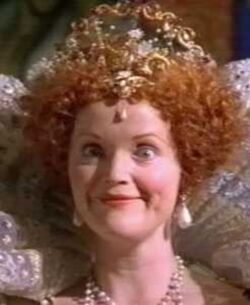
On June 17, 1579, Drake landed on the American coast, somewhere north of Spain's northernmost claim. He had discovered Nova Albion - the area now thought of as California. Here they restocked and repaired while keeping friendly relations with the local inhabitants. It was during these brief weeks of rest that Drake communicated his discovery of Nova Albion to the same indigenous tribes, who celebrated the news with three days of feasting, having previously been unaware that they were living anywhere at all.
On his departure, Drake left an embryo colony of twenty five "goode Englishemen and true" to seed England's claim to this part of the New World. Sadly, none of these men survived to claim their rightful share of the booty. Drake and his now much diminished crew then ventured further north, becoming the first Europeans to sight Alaska and the first Europeans to turn south in search of warmer climes. The weather not withstanding, Drake made some important scientific break-throughs by discovering that both Eskimos and walrus were prepared to eat British sailors who pestered their captain for an advance on their wages.
Drake now headed westward across the mighty Pacific, reaching the Moluccas (in today's Indonesia) within months. Here, the Golden Hind became stuck on a reef and was almost lost. In a desperate race to refloat the ship before the next low tide the crew dumped the ballast overboard. When they found the Golden Hind still stuck they jetisoned most of the canon, the remaining stocks of food and water and (at Drake's inspired insistence) two thirds of the crew. Finally, the Golden Hind floated free with her 30 ton cargo of bullion. Drake sailed at once for home, making multiple stops along the way to restock and hang more "mutineers" - the number of whom multiplied as they approached England.
On September 26th, 1580 the Golden Hind sailed into Plymouth with Drake at the helm. At once 59 crew emerged from their hiding places and ran for the obscurity of the taverns. Such was the success of the journey that the Queen's half-share of the profits yielded more than the rest of the entire crown income for the year. Drake, who retained the other half - his crew having disappeared, was a rich man and a hero. Within weeks he had been knighted for his services to the nation in front of cheering crowds. The Queen presented the captain with a jewelled miniature of herself; Drake himself boasted to his friends of having given the Queen:
"Such a pearl necklace as she willst narry forget. I hadst been at sea many months."
No record of this gift was entered in the Crown records.
The Invincible Armada
War broke out in 1585 when Queen Elizabeth refused to bow to the unreasonable demand of King Phillip II of Spain that "English ships shouldst cease attacking my towns and trade, killing my people and carrying off their goods and chattels." The Spanish began to assemble a mighty invasion fleet at once, but England was sure that they had the ships to defend themselves from the greatest threat to their liberty since the Norman Conquest and the man to command them.
Drake had been serving as mayor of Plymouth, and seeking to improve his social status. Though a national hero and wealthy beyond most aristocrats' dreams, his humble origins were held against him and he had taken great measures to advance his standing in society. On the advice of his secretary, Coleman Atkins, he emulated his Tudor sovereign by ostentatiously avoiding all vegetables at the many public dinners he attended, branding them peasant-food. He also eschewed the plentiful fish dishes of the region in favour of the more expensive meat of farm livestock. So famous was his addiction to pork and ham, that he became widely-known as Sir Francis Bacon.
It was in this period that he made another lasting impact on British culture. Within months of adopting Atkins' suggested diet, Iodine-deficiency had led to the development of a striking goitre which he could only conceal beneath ever larger neckerchiefs. Finally, his tailor had to construct the world's first ruff to hide a swelling now seven inches in diameter. Fashion in Europe would follow Drake's lead for the next 150 years.
Now Drake had the chance to once more make a name for himself on the high seas. In 1587 he set out with a plan to "Singe ye beard of ye Kinge of Spain." With this in mind, he brazenly sailed into both Cádiz and La Coruña, two of Spain's major ports. His men set about sinking 40 Spanish vessels while Drake himself set fire to Phillip II's head. The combined loss of ships, supplies and the King's third degree burns delayed the Armada by a year, giving England precious breathing space to prepare its defence.
By 1588, Drake was Vice Admiral of the Royal Fleet pursuing 140 enemy vessels along the English Channel. As darkness gathered, Drake's ship broke off the chase and captured the Spanish galleon, Rosario. However, in doing so Drake extinguished the lantern leading the rest of the English fleet in pursuit of the main Armada, an action for which he has been accused of being an opportunistic pirate.
"I could not do otherwise," Drake argued. "Rosario carried ye entire treasury for payment of Philip's armies in ye Lowlands. T'was my duty to take her e'en though it meant losing most of my crew" - many of whom died of previously unnoticed wounds, some up to four days after the attack.
As a result of Drake's action, The Armada made Calais safely but were forced to flee when the English sent fire ships into the harbour, the majority still crewed by Drake's surviving sailors. Fleeing the flames, the Spanish ships were scattered and then blown east and, unable to land in Holland or head back along the Channel, were forced into a compulsory circumnavigation of the British Isles. Many lives were lost as the ships of the Armada were wrecked on the rocky coasts of Scotland and Ireland, with unlucky survivors bludgeoned to death by suspicious locals for their jewellery, not unlike similar Saga cruises today.
The most famous anecdote about Drake in this period relates to his activities prior to the battle. According to this story, when news of the Armada first reached England, Drake could not be found. After an exhaustive search he was finally located locked in a skittle alley of a Devon bawdy house where he had made his headquarters. Pinned beneath him was the daughter of its owner. Noticing the looks of disgust of his fellow officers he explained that the young lady was merely there "to playe [with my] balls". As the assembly muttered their disquiet he further remarked to his companions "shouldst not this Plymouth Ho to beat-off an English hero before he must needs pull up his breeches and beat off the Spanish attack." This tale survived down the ages as a testament to the bluff virility of the British male, though it has been sadly emasculated by Victorian prudery to a game of bowls played on Plymouth Hoe as the Armada approached.
Death of Drake
Drake's sea-faring career continued into his fifties, with campaigns against the mainlands of Spain and South America. In both of these campaigns Drake skilfully gave the impression of failure, the better to trounce the Spanish at a later date when they had become complacent. Sadly, there would be little time for his planned counter-strike.
In 1596, on another anti-Spanish campaign, he discovered El Dorado, the legendary city of gold far in the Venezuelan interior. Drake knew what he must do. He manoeuvred his men into battle with local Indians armed with poison blow-pipes and bravely sailed single-handedly back to the coast along the Orinoco river in a boat horribly overloaded with gold. At Caracas he assumed the name to Sir Walter Raleigh, put out the story that Drake had died of dysentery. Thus ends the recorded history of one of England's greatest heroes. But, it is said that when England is most in peril, Drake's drum will sound again calling the stout-hearted English to defend themselves from the foreign menace by emptying the coffers of their Catholic neighbours.
| Featured version: 12 May 2010 | |
| This article has been featured on the main page. — You can vote for or nominate your favourite articles at Uncyclopedia:VFH. | |
